LinkedIn marketing for lawyers isn’t just about maintaining another social network—it’s where legal professionals go to build authority, grow influence, and attract real business through strategic LinkedIn marketing. 87% of law firms now use LinkedIn as part of their social media marketing strategy.
But simply having a profile isn’t enough. If your presence looks outdated, inactive, or impersonal, you’re not just being overlooked—you’re losing credibility.
LinkedIn is no longer just about job hunting. It’s a powerful platform where lawyers are landing high-value clients, forming strong referral partnerships, and becoming thought leaders in their fields.
This guide will show you how to use LinkedIn strategically, so you’re not just present, but prominent. Let’s turn your profile into a powerful tool that drives growth, not just views.

Why LinkedIn Strategy for Law Firms Matters More than Ever
Picture this: A startup founder needs help with a complex merger. A real estate developer faces a zoning nightmare. An executive was wrongfully terminated.
Where do they turn first? Not the Yellow Pages. Not even Google, necessarily.
They head to LinkedIn, where they can see your credentials, read your insights, and get a feel for who you are before they ever pick up the phone.
The LinkedIn Opportunity Most Lawyers Miss
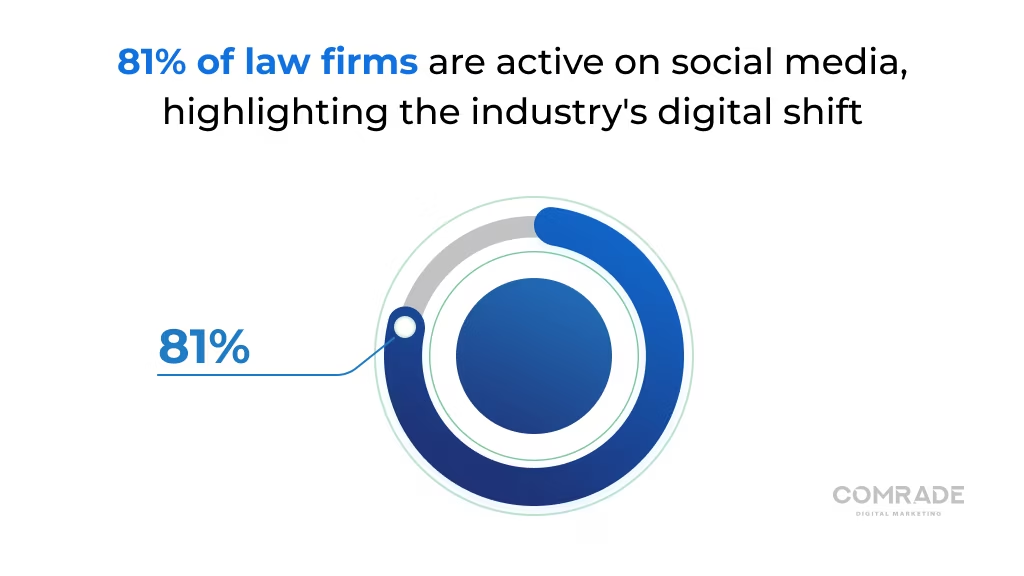
- 277% – That’s how much more effective LinkedIn is at generating leads compared to Facebook and Twitter, according to HubSpot.
- 10.7% of the world’s population is LinkedIn users, reflecting the platform’s vast and growing professional network.
- 81% of law firms report being active on social media, underscoring the industry’s shift toward digital engagement.
If your LinkedIn presence is weak, you’re not just missing connections — you’re missing cases.
It’s Not About Being Social — It’s About Being Strategic
LinkedIn isn’t Facebook for suits. It’s a 24/7 business development tool that:
- Showcases your expertise without the hard sell
- Builds trust before the first consultation
- Generates warm referrals from your network
- Positions you as the obvious choice in your practice area
The Game Has Changed: Digital Networking Is Non-Negotiable
The days of relying solely on country club connections and bar association mixers are over. Today’s legal clients — especially business clients — expect to research you online first.
A polished LinkedIn presence signals that you’re current, credible, and worth their investment. A neglected profile? It suggests you might handle their case with the same lack of attention.
That’s right. Even if you’re the sharpest attorney in town, a weak LinkedIn game could make you invisible to your ideal clients.
This Guide Is Your Competitive Edge
We’re about to show you exactly what works in 2025 — from profile optimization to content strategies that convert connections into clients.
1. Create a Professional Lawyer LinkedIn Profile That Converts
First impressions happen fast—especially online. With effective social media marketing for lawyers, your LinkedIn profile can open doors. Don’t let it fall flat.
Most lawyer profiles are boring résumés in disguise. They list credentials, drone on about law school, and use language that would put a caffeinated judge to sleep.
Your profile should answer one question: “Why should I hire you?”
Craft a Headline That Stops the Scroll
Skip the generic “Attorney at Law” or “Partner at Smith & Associates.”
Your headline is prime real estate. Use it to showcase your value proposition.
- Instead of: “Corporate Attorney | Smith Law Firm”
- Try: “M&A Attorney Helping Tech Companies Navigate Complex Acquisitions | $2B+ in Successful Deals”
- Or: “Employment Lawyer Protecting Executive Careers | Former Fortune 500 HR Director”
Include your specialty, target client, and unique value — all in 220 characters or less.
Write an About Section That Connects
Your About section isn’t your bio — it’s your pitch. And it should speak directly to your ideal client’s pain points.
Start with empathy, not ego:
Weak opening: “I am a seasoned attorney with 15 years of experience in intellectual property law…”
Strong opening: “Watching your competitors profit from your innovation is painful. I help tech founders protect what they’ve built — before it’s too late.”
Structure your About section to:
- Lead with client problems you solve
- Share your unique approach or philosophy
- Include specific results or case wins (without violating confidentiality)
- End with a clear call to action
Choose a Professional Headshot That Builds Trust
Using that grainy snapshot from your nephew’s wedding as your LinkedIn profile photo?
It’s time to ditch it. Your professional headshot photo for LinkedIn needs to be:
- Current (within the last 2 years)
- Professional but approachable
- Well-lit with a clean background
- Showing you in professional attire
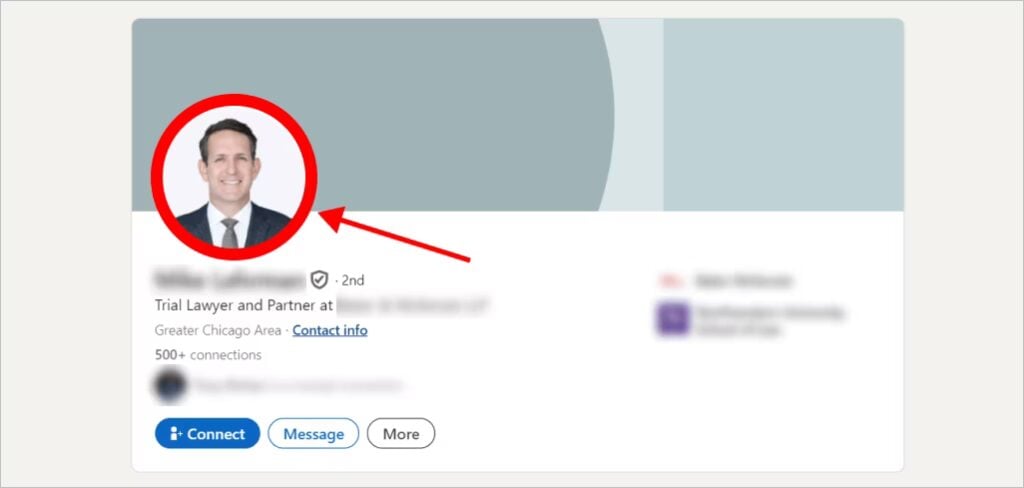
Optimize Your Experience Section for Relevance
It’s not enough to list just your job title and dates. Show how you made a difference and what you accomplished.
For each position, include:
- 2-3 key accomplishments or notable cases
- Types of clients you’ve served
- Specific practice areas or industries
- Any unique expertise or certifications

Use numbers when possible: “Negotiated 50+ commercial leases totaling $100M+” sounds better than “Handled commercial real estate transactions.”
Remember: Every element of your LinkedIn lawyer profile should reinforce why you’re the right choice for your ideal client. If it doesn’t serve that purpose, cut it.
2. Strategically Grow Your Legal Network
Having 500+ connections means nothing if they’re not the right connections.
Smart attorneys implementing LinkedIn for attorneys treat it like a digital Rolodex on steroids, using it to build strategic relationships that drive referrals, partnerships, and direct client leads. When paired with effective SEM for lawyers, it becomes a powerful client-generating machine.
Connect With Purpose, Not Volume
When it comes to LinkedIn, quality always beats quantity. Instead of collecting connections just for the numbers, focus on building professional relationships that truly matter to your legal practice. Be intentional about who you connect with:
- Current and former clients (within ethical and professional boundaries)
- Colleagues at other firms who may refer overflow work
- Professionals your clients often collaborate with—like accountants, consultants, and bankers
- General counsels and in-house legal departments
- Business owners in your target industries
The right connections can lead to real opportunities—so connect with purpose, not just for the sake of it.
Personalize Every Connection Request
Generic connection requests scream “spam.” Stand out with personalized messages:
Generic: “I’d like to add you to my professional network on LinkedIn.”
Personalized: “Hi Sarah, I noticed we both work with healthcare startups in Austin. Your recent post about HIPAA compliance challenges resonated. Would love to connect and share insights.”
Keep it under 300 characters, mention something specific, and focus on mutual value.
Join Relevant Groups Where Your Clients Hang Out
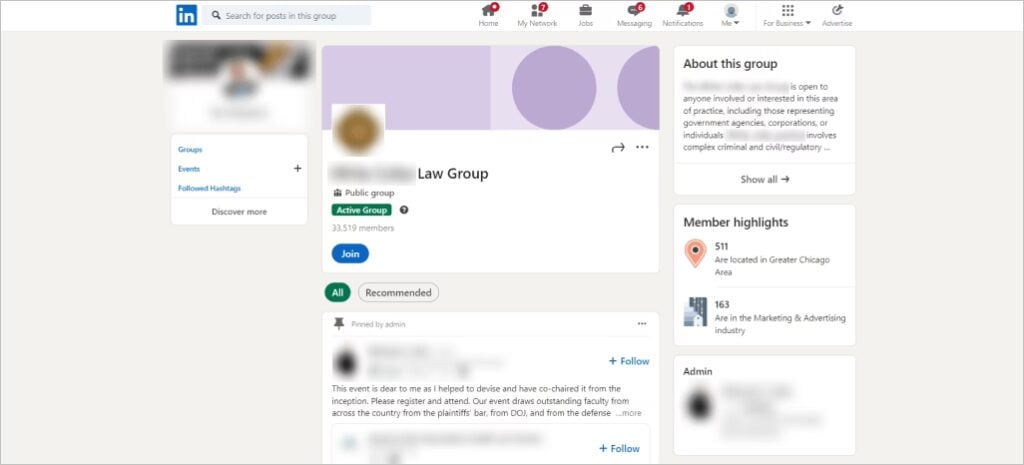
Legal-only groups are echo chambers. The real opportunities are where your clients gather.
If you’re a startup lawyer, join entrepreneur LinkedIn groups. Real estate attorney? Find developer and investor communities. Employment lawyer? HR professional groups are goldmines.
Engage genuinely — answer questions, share insights, and build relationships before pitching services.
Nurture Your Network (Or Watch It Wither)
Building connections is step one. Staying visible is the real game.
Set aside 15 minutes weekly to:
- Comment thoughtfully on connections’ posts
- Share relevant articles with personal insights
- Congratulate connections on their achievements
- Send occasional check-in messages to key contacts
Tools like LinkedIn Sales Navigator can help track important connections and trigger outreach reminders.
Your network is your net worth — but only if you work it strategically.
3. Publish Insightful, Practice-Relevant Content
Posting your law firm’s holiday party photos won’t land you clients. Sharing valuable insights will.
Legal LinkedIn marketing and content strategy isn’t about going viral — it’s about demonstrating expertise to the right audience at the right time.
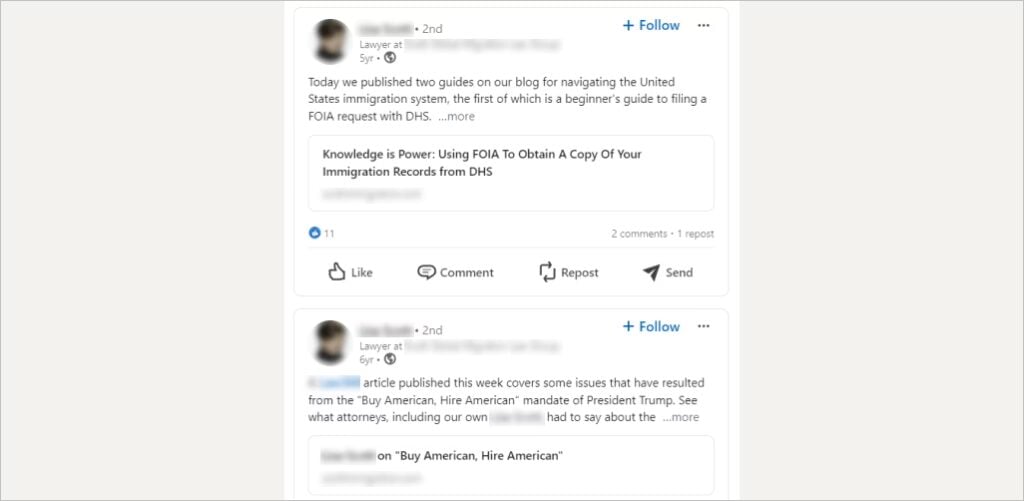
Share Knowledge That Matters to Your Market
Your ideal clients have questions. Answer them publicly.
Skip the legal jargon and academic debates. Focus on practical content that helps your target audience:
- “5 Mistakes Startups Make in Term Sheets (And How to Avoid Them)”
- “What Every Commercial Landlord Should Know About Force Majeure Post-COVID”
- “Red Flags to Watch for in Your Employment Contract”
The goal: Be helpful first, hireable second.
Develop a Consistent Content Calendar
Sporadic posting signals sporadic thinking. Build credibility through consistency:
- Weekly: Share one original article or insight post
- 2-3x/week: Comment meaningfully on others’ content
- Monthly: Publish a longer-form LinkedIn article on trending topics
Use scheduling tools to maintain presence even during busy trial weeks.
Write for Humans, Not Law Journals
Your law review article was impressive. Your LinkedIn audience doesn’t care.
Transform complex legal concepts into digestible insights:
Academic: “The jurisprudential implications of recent appellate decisions regarding non-compete enforceability…”
LinkedIn-friendly: “Can your employer stop you from working for a competitor? Here’s what changed last month…”
Use short paragraphs, bullet points, and concrete examples. If your grandmother wouldn’t understand it, rewrite it.
Leverage Different Content Formats
Mix up your content to maximize engagement:
- Text posts: Quick tips or observations (highest engagement)
- Articles: Deep dives into complex topics
- Videos: 60-second explanations of common legal questions
- Polls: Gauge opinions on industry issues
- Case studies: Anonymized client success stories
Pro tip: Native LinkedIn video gets 5x more engagement than YouTube links.
Engage With Comments Like a Pro
The real networking happens in the comments. When others engage with your content:
- Respond to every meaningful comment within 24 hours
- Ask follow-up questions to deepen discussions
- Thank people for sharing or adding insights
- Connect with engaged commenters privately
Remember: Every piece of content is an opportunity to showcase your expertise and build relationships. Make them count.
4. Collect Credible Recommendations and Endorsements
Your bio says you’re an excellent lawyer. But when do clients and colleagues say it? That’s pure law firm digital marketing gold.
LinkedIn recommendations carry more weight than anonymous reviews — they’re public endorsements from real professionals with real reputations on the line.
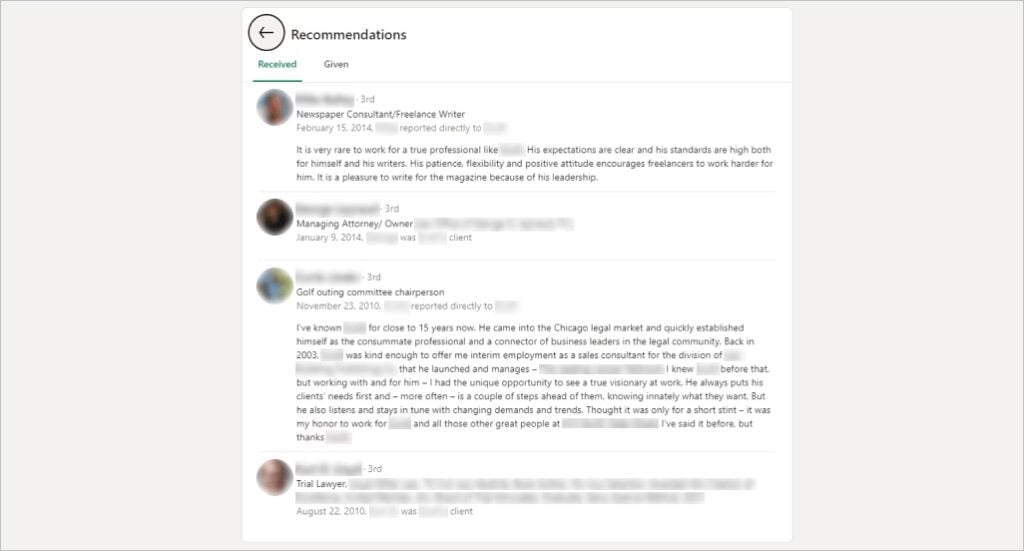
Request Recommendations Strategically
Timing is everything. Ask for recommendations when the relationship is warm:
- Right after winning a case or closing a deal
- Following positive feedback on your work
- When clients mention how helpful you’ve been
- After successful collaboration with colleagues
Make it easy with templates they can customize:
“Hi [Name], I’m updating my LinkedIn profile to better reflect my current practice. Would you be comfortable writing a brief recommendation highlighting our work on [specific matter]? I’m happy to provide talking points if helpful. Of course, I’d be glad to reciprocate.”
Guide Without Ghostwriting
The best recommendations are specific and results-focused. Provide gentle guidance:
- Mention the specific matter or timeframe
- Suggest highlighting particular skills or outcomes
- Remind them of quantifiable results when appropriate
- Encourage authenticity over generic praise
Weak recommendation: “John is a great lawyer. Very professional and knowledgeable.”
Strong recommendation: “John guided our startup through a complex Series A raise, anticipating investor concerns I hadn’t even considered. His strategic thinking saved us weeks of negotiations and helped secure better terms.”
Showcase the Right Mix
Aim for recommendations that demonstrate breadth:
- 40% from clients (within ethical boundaries)
- 30% from colleagues who’ve seen your work
- 20% from supervisors or mentors
- 10% from other legal professionals (co-counsel, experts, etc.)
Give to Get
Want to make the most of your network? Start by writing genuine recommendations for others. It’s one of the easiest ways to strengthen relationships, encourage others to do the same for you, and show that you’re truly engaged. Plus, a well-written recommendation doesn’t just lift someone — it sets the bar for what great feedback looks like.
Display Recommendations Strategically
LinkedIn lets you choose which recommendations to display. Prioritize those that:
- Align with your current practice focus
- Come from recognizable names or companies
- Include specific, impressive outcomes
- Represent recent work (within 2-3 years)
Remember: Third-party validation trumps self-promotion every time. Let others sing your praises while you focus on delivering results.
5. Tailor Your LinkedIn Profile for Maximum Search Impact
You could be the perfect lawyer for someone’s needs — but if they can’t find you on LinkedIn, you might as well not exist.
LinkedIn SEO for law firms isn’t complicated, but most lawyers ignore it completely. With a few strategic tweaks, you’ll show up exactly when prospective clients and referral sources are looking.
Keyword Optimization Without Keyword Stuffing
LinkedIn’s algorithm favors relevance over repetition, so keyword optimization is about strategy, not stuffing. The goal is to seamlessly integrate keywords that reflect your legal expertise and appeal to your ideal clients.

Start by identifying the right keywords for your profile:
- Practice areas (e.g., employment law, M&A, intellectual property)
- Client-facing terms (e.g., startup lawyer, construction attorney)
- Location-based phrases (e.g., Chicago business lawyer, Texas employment attorney)
- Special designations (e.g., certified mediator, registered patent attorney)
Once you’ve got the right terms, position them thoughtfully. Use them in your headline, work them naturally into your About section, include them in your experience summaries, and reinforce them in your Skills. The key is to make your profile searchable and engaging, without it feeling forced.
Avoid the rookie mistake: Don’t write “divorce lawyer, divorce attorney, divorce legal services, Chicago divorce…” That’s spam, not strategy.
Customize Your LinkedIn URL
That random string of numbers in your LinkedIn URL? Fix it now.
Change linkedin.com/in/john-smith-8a6b5321 to linkedin.com/in/johnsmithIPattorney

A clean URL:
- Looks professional on business cards
- Improves search rankings
- It makes it easier to find
- Shows attention to detail
Complete Every Profile Section
LinkedIn favors fully completed profiles—so don’t leave yours half-done. Add your legal industry, location, contact details, featured content like articles or big wins, and show off your volunteer work, publications, honors, and top skills. The more complete your profile, the more you’re rewarded with up to 40% more opportunities.
Use LinkedIn’s Featured Section
This underused tool lets you showcase:
- Published articles or thought leadership
- Media mentions or interviews
- Speaking engagement videos
- Significant case wins (appropriately anonymized)
- Industry recognition or awards
Think of it as your highlight reel — curated proof of your expertise.
Align Your Profile With Search Intent
Consider how clients search:
They don’t search: “Attorney with JD from prestigious institution”
They search: “Employment lawyer wrongful termination San Francisco”
They don’t search: “Experienced legal professional”
They search: “Startup lawyer equity compensation”
Write for how real clients think and search, not how lawyers talk to each other.
Pro tip: Ask recent clients what they searched for when looking for legal help. Their language is your keyword goldmine.
6. Track Performance Metrics to Refine Your LinkedIn Approach
Implementing a LinkedIn marketing strategy for law firms without checking results is like arguing to an empty courtroom — pointless and exhausting.
LinkedIn provides robust analytics, but most lawyers never look at them. That’s like leaving money on the table.
Monitor Your Profile Analytics

LinkedIn shows you exactly who’s viewing your profile. Pay attention to:
- Search appearances: How often do you show up in searches
- Profile views: Who’s checking you out
- View trends: Spikes often follow good content
- Viewer demographics: Titles, companies, and industries
If corporate counsel is viewing your profile but you’re targeting startups, adjust your messaging.
Analyze Your Content Performance
Every post tells a story through data:
- Impressions: How many people saw it
- Engagement rate: Likes, comments, and shares divided by impressions
- Click-through rate: How many clicked to read more or view your profile
- Follower growth: New connections after posting
Track patterns: Do how-to posts outperform industry news? Do morning posts beat afternoon? Use what works.
Set Meaningful KPIs
Vanity metrics might boost your ego, but they won’t grow your business. Instead of chasing likes and random followers, zero in on what truly drives results—views from your ideal clients, genuine connection requests, InMail replies, and conversations that lead to consultations. That’s the kind of data worth tracking.
Create a Simple Tracking System
You don’t need fancy software. A basic spreadsheet works:
- Column A: Date posted
- Column B: Content type (article, tip, case study)
- Column C: Topic
- Column D: Impressions
- Column E: Engagements
- Column F: Profile views within 48 hours
- Column G: Quality leads generated
Review monthly and double down on what works.
Test, Learn, and Optimize
LinkedIn success isn’t about perfection — it’s about iteration:
- Week 1-2: Post different content types
- Week 3: Analyze what performed best
- Week 4: Create more of what worked
- Month 2: Refine based on results
Small improvements compound. A 10% better headline, 20% more engaging content, and 15% better timing add up to dramatically better results.
Use AI to Amplify Insights
Tools like Shield Analytics or AuthoredUp can automate tracking and surface patterns you might miss. They’ll show you:
- Best posting times for your audience
- Content formats that drive engagement
- Trending topics in your network
- Competitor strategies that work
Remember: The lawyers winning on LinkedIn aren’t necessarily the best lawyers — they’re the ones who pay attention to what works and do more of it.
You Invested Everything in Your Legal Career — Is It Paying Off?
LinkedIn marketing for lawyers offers a powerful platform for attorneys to build credibility, enhance legal networking opportunities, and grow their practice through professional connections. With the right approach, it becomes more than just a networking site—it turns into a steady source of leads and authority.
From optimizing profiles to sharing valuable legal content, consistency is key. Lawyers who commit to an active presence often see improved engagement and stronger reputations in their field.
If your firm needs help navigating LinkedIn or wants to create a strategy that delivers results, professional support can make all the difference. That’s where expert digital guidance comes in.
Comrade Digital Marketing specializes in helping law firms succeed online. Book a free consultation today and let’s elevate your LinkedIn strategy together.
Frequently Asked Questions
-
How should I handle negative comments or reviews on LinkedIn?
When dealing with negative comments, respond calmly and professionally to show your commitment to your law firm’s brand. Avoid getting defensive—acknowledge concerns, clarify misunderstandings, and offer to continue the conversation privately. This approach helps reinforce your credibility on the social media platform and protects your reputation.
-
How often should I post content on LinkedIn?
To keep your audience engaged and build your brand, aim to post at least 2–3 times a week. Mix it up with valuable insights, updates from your LinkedIn company page, and relevant discussions like legal processes interviews to maintain a balanced presence that reflects your expertise.
-
What should I avoid posting on LinkedIn?
Avoid overly personal content, vague messages with just a job title, or irrelevant visuals. Steer clear of polarizing opinions or anything that undermines your professionalism. Instead, focus on clear messaging, appropriate tone, and visuals like a strong background photo to support your position as a trusted personal injury attorney.
